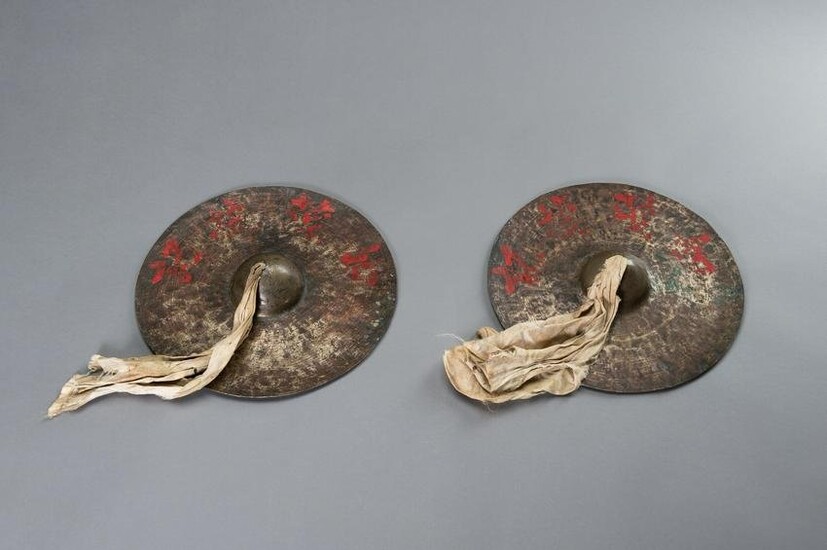A PAIR OF BRONZE BO CYMBALS
A PAIR OF BRONZE BO CYMBALS
Tibet, 19th century. Each with a broad, flat rim that is slightly curved upward and domed top. The rim painted in red with characters and still conserving the original cloth straps.
Bo is the generic name for pairs of cymbals that come in a variety of sizes, all with rims that curl upward at the edges. Bo are used together with gongs and drums for military music and play a prominent role in opera productions, where they accent the actors' movements. Several playing techniques may be employed: the discs may be clashed together or held horizontally, with one raking across the other to produce a sustained rolling sound. In Tibetan processions and dance, drums and cymbals set up basic rhythmic patterns for wind instruments, and in temple settings are used with bells to accompany chant.
Condition: Good condition, commensurate with age. Extensive old wear and casting flaws, minor dings and dents, shallow surface scratches, soiling, and warping. One with two cracks to the rim.
Provenance: Austrian private collection.
Weight: 1417 (total)
Dimensions: Diameter 31 cm each
Literature comparison: Compare a pair of bronze cymbals dated to the late 17th century in the collection of the Metropolitan Museum of Art, accession number 2003.465a–d. Another pair of bronze cymbals from the Xuande period can be found in the Tibet Museum in Lhasa, and pair of bronze cymbals from the Jin dynastyis exhibited in the Shaanxi Provincial Museum.
Estimate
Time, Location
Auction House
A PAIR OF BRONZE BO CYMBALS
Tibet, 19th century. Each with a broad, flat rim that is slightly curved upward and domed top. The rim painted in red with characters and still conserving the original cloth straps.
Bo is the generic name for pairs of cymbals that come in a variety of sizes, all with rims that curl upward at the edges. Bo are used together with gongs and drums for military music and play a prominent role in opera productions, where they accent the actors' movements. Several playing techniques may be employed: the discs may be clashed together or held horizontally, with one raking across the other to produce a sustained rolling sound. In Tibetan processions and dance, drums and cymbals set up basic rhythmic patterns for wind instruments, and in temple settings are used with bells to accompany chant.
Condition: Good condition, commensurate with age. Extensive old wear and casting flaws, minor dings and dents, shallow surface scratches, soiling, and warping. One with two cracks to the rim.
Provenance: Austrian private collection.
Weight: 1417 (total)
Dimensions: Diameter 31 cm each
Literature comparison: Compare a pair of bronze cymbals dated to the late 17th century in the collection of the Metropolitan Museum of Art, accession number 2003.465a–d. Another pair of bronze cymbals from the Xuande period can be found in the Tibet Museum in Lhasa, and pair of bronze cymbals from the Jin dynastyis exhibited in the Shaanxi Provincial Museum.



